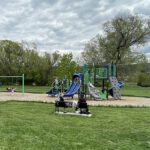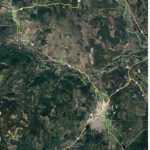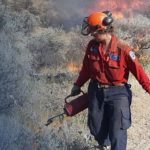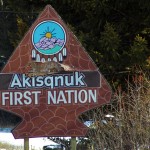Home »

Cooperation key to stopping spread of invasives in region
By Nicole Trigg
Kootenay Conservation Program
An appreciation and love for the natural world is what led Kendal Benesh into the field of biology, but throughout her career she’s discovered a new, yet complementary, passion: bringing people together to solve problems and find efficiencies.
“My role with East Kootenay Invasive Species Council (EKISC) is hitting that straight on the head,” said Kendal, who stepped into the role of program manager for EKISC in March 2019. “Invasive species are going to be here forever. We’re always going to be dealing with new introductions and they will continue to impact people in a variety of ways, so there’s an endless amount of strategy and innovation that needs to be in place with invasive species management.”
Originally from the Okanagan, Kendal earned her Bachelor of Science in biology and environmental studies from the University of Victoria, then moved to Alberta where she spent a number of years working for the Alberta Biodiversity Monitoring Institute in a variety of roles, from caribou monitoring to coordinating large-scale biodiversity management to training and managing field technician crews. Kendal also worked as an environmental and natural resources educator for students in West-Central Alberta before relocating to Kelowna as a self-employed project consultant, providing support for various wildlife projects in the capacities of field work, research and public communication. Accepting the EKISC program manager position is what brought Kendal to the East Kootenay.
“What drew me to this position was the land use planning and stakeholder engagement piece for sure,” she said. “Being exposed to working across different habitat types and with different stakeholders, my career trajectory has continued to move in the direction of connecting people on multi-use landscapes to support collaborative planning and to foster stewardship practices.”
One of 13 regional organizations in British Columbia that coordinate localized invasive species management within a region, EKISC brings together many different land managers and stakeholders, including all levels of government, other stewardship organizations, land base user groups and the public, to grow awareness and problem solve in the most effective way possible. EKISC works primarily with plants, but is also involved in the lake monitoring for invasive zebra and quagga mussels and is also the main delivery agency for education and outreach regarding all invasive species in the region.
“I think we’re incredibly lucky as an organization. In the East Kootenay I feel that there’s a long legacy of people putting their blood, sweat and tears into invasive species management,” said Kendal. “Because invasive species don’t know boundaries, they easily cross jurisdictions from private to public land, so it’s essential that people are able to work together and collaborate.”
When it comes to invasive species, prevention is by far the best approach, which means reducing or preventing their introduction and spread. In order to achieve this, a change in behaviour is needed, which is what a number of EKISC campaigns address, such as the CLEAN DRAIN DRY around vessel care to prevent the spread of zebra and quagga mussels, and CLEAN PLAY GO, which is about raising awareness around cleaning off recreation equipment.

Although EKISC works regionally, they also manage many independent projects, such as the Strategic Invasive Plant Control of Leafy Spurge (SIPCoLS) project in the Columbia Valley, which involves the chemical control of Leafy Spurge in a more intensive and coordinated method on Crown land in the area.
In 2020, EKISC kicked off a new project in the upper Elk Valley that is bringing together local land managers, user groups and recreational groups to support new invasive species treatments and support healthy ecosystems in that area. EKISC also has a program whereby they support Crown land range tenure holders to manage invasive weeds on their Crown land range tenure.
“When we can bring people together and garner support from so many different angles and groups, we’re able to accomplish so much more… we can go above and beyond what would typically be done if there was only a single group working on a project.”
There are dozens of different invasive species EKISC is working to keep at bay or under control, ranging from species on their containment or management list to those on the Provincial Early Detection Rapid Response list managed by the province.
“All of our contractors and staff are trained in these early detection rapid response species and other high priority species in the region. We also educate the general public, user groups, or any folks spending time on the land, so they know what to look for and what to do when they find something,” said Kendal.
EKISC encourages anyone who is working on the land base — whether its ecosystem restoration, farming, real estate development, natural resource extraction, etc. — to consider invasive plants in their project work.
“We encourage everyone to get educated on what species are threatening our local ecosystems, complete an invasive plant inventory, and make a plan to manage those species and make sure they aren’t spreading them” said Kendal. “There are lots of resources available in the region and so much expertise to draw on. If you don’t know where to start, we can help you!”
The mobile Report Invasives BC app is available free of charge for iPhone and Android platforms. Reports for the East Kootenay region go directly to provincial experts for verification, who coordinate with EKISC for follow-up activities when required.
Visit the EKISC website to learn more and sign up for their newsletter.
The Kootenay Conservation Program (KCP) is a partnership of 80 organizations that work together to protect clean water, conserve important wildlife habitat, and steward the land to allow for healthy, functioning ecosystems in the East and West Kootenays. Learn more at www.kootenayconservation.ca.
Photo submitted
e-KNOW








